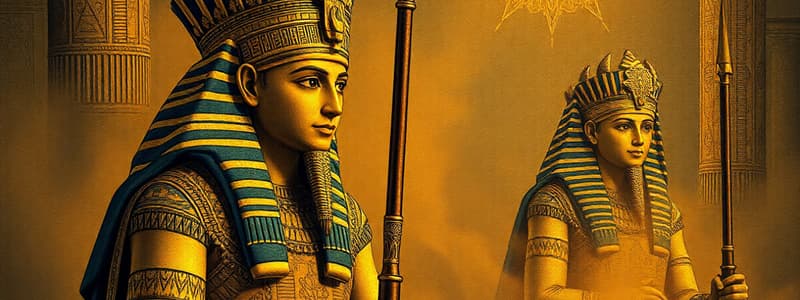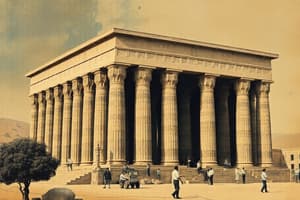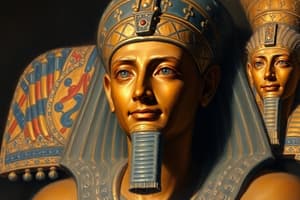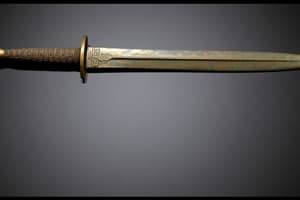Podcast
Questions and Answers
What does the presence of Ramses II's insignia on the sword suggest about its ownership?
What does the presence of Ramses II's insignia on the sword suggest about its ownership?
- It was likely a royal gift to a high-ranking officer. (correct)
- It indicates it was a ceremonial weapon.
- It belonged to a common soldier.
- It signifies a trade between Egypt and another civilization.
What aspect of daily life did the discoveries at the ancient fort reveal?
What aspect of daily life did the discoveries at the ancient fort reveal?
- Military strategies of Ramses II.
- The form of governance in ancient Egypt.
- A self-sufficient community with food storage. (correct)
- A reliance on trade for food supplies.
Which feature was NOT mentioned as part of the archaeological discoveries at the fort?
Which feature was NOT mentioned as part of the archaeological discoveries at the fort?
- Ancient Egyptian manuscripts. (correct)
- Bead necklaces.
- Weapons production area.
- Clay pots containing animal bones.
How long did Ramses II reign as pharaoh?
How long did Ramses II reign as pharaoh?
What type of item was the applicator found in the fort used for?
What type of item was the applicator found in the fort used for?
Which of the following best describes the significance of the pharaoh's emblem on the sword?
Which of the following best describes the significance of the pharaoh's emblem on the sword?
What does the term 'builder pharaoh' refer to in the context of Ramses II?
What does the term 'builder pharaoh' refer to in the context of Ramses II?
What evidence suggests that the fort had military significance?
What evidence suggests that the fort had military significance?
Flashcards
Who was Ramses II?
Who was Ramses II?
Ramses II, also known as Ramses the Great, was the second longest-reigning pharaoh in ancient Egypt. He ruled for 66 years, from 1279 to 1213 BCE, during the 19th Dynasty. He was known for his military achievements, expanding Egypt's borders significantly, and his extensive building projects.
What significant artifact was discovered near Tell Al-Abqain?
What significant artifact was discovered near Tell Al-Abqain?
A gleaming bronze sword, marked with the insignia of Ramses II, was discovered in a mud barracks near Tell Al-Abqain, a 3,200-year-old military fort in northwest Egypt. Its preservation after 3,000 years suggests it originally belonged to a high-ranking military official.
How did Ramses II's insignia on the sword impact its meaning?
How did Ramses II's insignia on the sword impact its meaning?
The presence of Ramses II's emblem on the sword indicates its significance as a royal gift or a symbol of the owner's status. It suggests a connection between the fort and the pharaoh's authority.
What evidence indicates daily life within the fort?
What evidence indicates daily life within the fort?
Signup and view all the flashcards
What can be inferred about the fort's strategic importance?
What can be inferred about the fort's strategic importance?
Signup and view all the flashcards
What was kohl and how was it used?
What was kohl and how was it used?
Signup and view all the flashcards
How do personal items found in the fort reveal insights into the soldiers' lives?
How do personal items found in the fort reveal insights into the soldiers' lives?
Signup and view all the flashcards
What inscription was discovered in the fort, and what does it suggest?
What inscription was discovered in the fort, and what does it suggest?
Signup and view all the flashcards
Study Notes
Egyptian Bronze Sword Discovery
- Bronze sword, bearing the insignia of Ramses II, unearthed in Tell Al-Abqain fort (Northwest Egypt).
- Sword remarkably preserved after over 3,000 years in burial.
- Sword found inside a room of a mud barrack, part of a 3,200-year-old military fort.
- The presence of Ramses II's insignia suggests it belonged to a high-ranking military official.
Significance of the Discovery
- Suggests well-defended fort, potentially with an on-site weapons production area.
- Implies the sword was a royal gift to a high-ranking officer.
- King's name on weapon served as status symbol.
Daily Life Insights from the Fort
- Storerooms for grain storage and ovens for baking unearthed, indicating self-sufficient community.
- Evidence of a diverse diet (fish and other animals).
- Personal artifacts like bead necklaces and kohl applicators revealed.
- Kohl (dark powder) protected eyes from the sun in ancient Egypt.
Ramses II: Powerful Pharaoh
- Ramses II (Ramses the Great) reigned for 66 years (1279-1213 BCE).
- Second longest-reigning pharaoh in ancient Egypt.
- Third pharaoh of the 19th Dynasty.
- Known for military prowess and significant expansion of Egypt's territory (Syria to Sudan).
- Nicknamed the "builder pharaoh" for numerous temples and monuments commissioned.
Additional Findings
- Limestone blocks engraved with names ("Bay" and Ramses).
Studying That Suits You
Use AI to generate personalized quizzes and flashcards to suit your learning preferences.
Description
Explore the recent discovery of a bronze sword bearing the insignia of Ramses II at Tell Al-Abqain, a 3,200-year-old military fort in Northwest Egypt. This quiz delves into the significance of the sword's preservation, insights into daily life from the fort's artifacts, and the power of Ramses II as a pharaoh.





